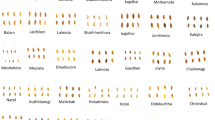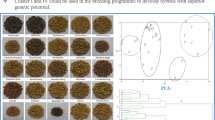Abstract
Jhinuwa is an aromatic rice (Oryza sativa L.) landrace from the Pokhara Valley of Nepal. A total of 210 accessions comprising seven types of Jhinuwa rice landraces were randomly collected from the rice fields to evaluate inter- and intra-population variability based on agro-morphological traits. The experiment was conducted in factorial randomized complete block design with three replicates in 2005. The first six principal components (PCs) accounted for 76.6 % variation for agro-morphological traits. Major traits that accounted for the variation by six PCs includes days to heading, days to maturity, total grain panicle−1, fertile grain panicle−1, culm length, panicle length, milling recovery, head rice recovery, aroma, 1,000 grain weight, sterile grain panicle−1, grain sterility %, and leaf characteristics. Both principal coordinate analysis and cluster analyses revealed four phenotypic groups, two of which represent Bayarni, Jhinuwa, and Biramphul while the other two account for Tunde and Pakho Tunde. Tunde, Pakho Tunde, Kalo Bayarni, and Seto Bayarni showed higher intra- as well as inter-population variation compared to other populations. The phenotypic and genotypic coefficients of variation, broad sense heritability (h 2B) and genetic advance (GA) as a percent of the mean assessed for 210 accessions revealed high h 2B and GA estimates for leaf width, leaf length breadth ratio, ligule length, sterile grain panicle−1, grain sterility % and 1,000 grain weight. The current study demonstrates that improvement in Jhinuwa rice landrace is possible by selecting superior accessions from existing natural populations while selection should be focussed to market traits with higher h 2B and GA estimates.

Similar content being viewed by others
References
Amagain RB, Shrestha P, Joshi BK, Adhikari NP, Gyawali S, Upadhyay MP, Sthapit BR, Baniya BK (2005) On-farm evaluation of traits influencing outcrossing among rice (Oryza sativa L.) landraces of Central Terai, Kachorwa, Bara, Nepal In: Sthapit BR, Upadhyay MP, Shrestha PK, Jarvis DI (eds) On-farm conservation of agricultural biodiversity in Nepal. Volume I. Assessing the amount and distribution of genetic diversity on-farm. Proceedings of the Second National Workshop, Nagarkot, Nepal, 25–27 August 2004 2005. International Plant Genetic Resources Institute Rome, Italy, pp 54–63
Bajracharya J, Rana RB, Gauchan D, Sthapit BR, Jarvis DI, Witcombe JR (2010) Rice landrace diversity in Nepal. Socio-economic and ecological factors determining rice landrace diversity in three agro-ecozones of Nepal based on farm surveys. Genet Resour Crop Evol 57(7):1013–1022. doi:10.1007/s10722-010-9544-x
Brush SB (1995) In situ conservation of landraces in centers of crop diversity. Crop Sci 35(2):346–354. doi:10.2135/cropsci1995.0011183X003500020009x
Cleveland DA, Soleri D, Smith SE (1994) Do folk crop varieties have a role in sustainable agriculture? Incorporating folk varieties into the development of locally based agriculture may be the best approach. Bioscience 44(11):740–751
Dabholkar AR (1992) Elements of biometrical genetics. Concept publishing company, New Delhi, pp 117–187
Falconer DS (1981) Introduction to quantitative genetics Longman Scientific and Technical, London
FAO (2010) Second report on the world’s plant genetic resources for food and agriculture. Food and Agriculture Organization, Rome, Italy ftp://fao.org/docrep/fao/meeting/017/ak528e.pdf
Fukuoka S, Suu T, Ebana K, Trinh L, Nagamine T, Okuno K (2006) Diversity in phenotypic profiles in landrace populations of Vietnamese rice: a case study of agronomic characters for conserving crop genetic diversity on farm. Genet Resour Crop Evol 53(4):753–761. doi:10.1007/s10722-004-4635-1
Gauchan D, Smale M, Maxted N, Cole M (2006) Managing rice biodiversity on-farms: the choices of farmers and breeders in Nepal. In: Smale M (ed) Valuing crop biodiversity: on-farm genetic resources and economic change. CABI Publishing, Wallingford, pp 162–176
Genstat (2003) Genstat 7.2. Genstat, Inc., Lawes Agricultural trust, IACR, Rothamsted
Gyawali S, Sthapit BR, Bhandari B, Bajracharya J, Shrestha PK, Upadhyay MP, Jarvis DI (2010) Participatory crop improvement and formal release of Jethobudho rice landrace in Nepal. Euphytica 176(1):59–78. doi:10.1007/s10681-010-0213-0
Horsley RD, Schwarz PB, Hammond JJ (1995) Genetic diversity in malt quality of North American six-rowed spring barley. Crop Sci 35(1):113–118
Jarvis DI, Hodgkin T (1999) Wild relatives and crop cultivars: detecting natural introgression and farmer selection of new genetic combinations in agroecosystems. Mol Ecol 8(12 SUPPL. 1):S159–S173
Jarvis DI, Brown AHD, Pham HC, Collado-Panduro L, Latournerie-Moreno L, Gyawali S, Tanto T, Sawadogo M, Mar I, Sadiki M, Hue NTN, Arias-Reyes L, Balma D, Bajracharya J, Castillo F, Rijal D, Belqadi L, Rana R, Saidi S, Ouedraogo J, Zangre R, Rhrib K, Chavez JL, Schoen D, Sthapit B, De Santis P, Fadda C, Hodgkin T (2008) A global perspective of the richness and evenness of traditional crop-variety diversity maintained by farming communities. Proc Natl Acad Sci USA 105(14):5326–5331. doi:10.1073/pnas.0800607105
Johnson HW, Robinson HF, Comstock RE (1955) Estimates of genetic and environmental variability in soybeans. Agron J 47(7):314–318. doi:10.2134/agronj1955.00021962004700070009x
Joshi BK, KC HB, Upadhyay MP, Gupta SR, Lu BR, Mathur PN, Sthapit BR (2008) Ex situ and in situ management of wild and weedy rice in Nepal using a geographical information system. Plant Genet Resour Newsl 155:60–74
Khush GS (1997) Origin, dispersal, cultivation and variation of rice. Plant Mol Biol 35(1):25–34. doi:10.1023/a:1005810616885
Li YC, Roder MS, Fahima T, Kirzhner VM, Beiles A, Korol AB, Nevo E (2002) Climatic effects on microsatellite diversity in wild emmer wheat (Triticum dicoccoides) at the Yehudiyya microsite, Israel. Heredity 89(2):127–132
MacKey J (1988) A plant breeder’s aspect on the taxonomy of cultivated plants. Biol Zent Bl 107:369–379
Mathure S, Shaikh A, Renuka N, Wakte K, Jawali N, Thengane R, Nadaf A (2011) Characterisation of aromatic rice (Oryza sativa L.) germplasm and correlation between their agronomic and quality traits. Euphytica 179(2):237–246. doi:10.1007/s10681-010-0294-9
Patra BC, Dhua SR (2003) Agro-morphological diversity scenario in upland rice germplasm of Jeypore tract. Genet Resour Crop Evol 50(8):825–828. doi:10.1023/a:1025963411919
Poudel D, Johnsen FH (2009) Valuation of crop genetic resources in Kaski, Nepal: farmers’ willingness to pay for rice landraces conservation. J Environ Manage 90(1):483–491. doi:10.1016/j.jenvman.2007.12.020
Prain G, Hagmann J (2000) Farmers management of diversity in local systems. In: Almekinders C, de Boef W (eds) Encouraging diversity: the conservation and development of crop genetic resources. Intermediate Technology Publications, UK, pp 94–100
Rana RB, Garforth C, Sthapit B, Jarvis D (2007) Influence of socio-economic and cultural factors in rice varietal diversity management on-farm in Nepal. Agric Hum Values 24(4):461–472. doi:10.1007/s10460-007-9082-0
Rana RB, Garforth CJ, Sthapit BR (2009) Farmers’ management of rice varietal diversity in the mid-hills of Nepal: implications for on-farm conservation and crop improvement. Plant Genet Resour 7(1):50–62. doi:10.1017/s1479262108048259
Rao SA, Khan MA, McNeilly T, Khan AA (1997) Cause and effect relations of yield and yield components in rice (Oryza sativa L.). J Genet Breed 51(1):1–5
Rieseberg LH (1997) Hybrid origins of plant species. Annu Rev Ecol Syst 28:359–389. doi:10.1146/annurev.ecolsys.28.1.359
Rijal DK, Kadayat KB, Joshi KD, Sthapit BR (1998) Inventory of indigenous rainfed and aromatic rice landraces in Seti River Valley, Pokhara, Nepal. LI-BIRD Technical paper No 2. LI-BIRD, Pokhara, p 29
Sanni KA, Fawole I, Ogunbayo A, Tia D, Somado EA, Futakuchi K, Sié M, Nwilene FE, Guei RG (2012) Multivariate analysis of diversity of landrace rice germplasm. Crop Sci 52(2):494–504. doi:10.2135/cropsci2010.12.0739
Sarhadi WA, Ookawa T, Yoshihashi T, Madadi AK, Yosofzai W, Oikawa Y, Hirata Y (2009) Characterization of aroma and agronomic traits in Afghan native rice cultivars. Plant Prod Sci 12(1):63–69. doi:10.1626/pps.12.63
Sharma RC, Chaudhary NK, Ojha B, Yadav L, Pandey MP, Shrestha SM (2007) Variation in rice landraces adapted to the lowlands and hills in Nepal. Plant Genet Resour 5(3):120–127. doi:10.1017/s1479262107837828
Sthapit BR, Rao VR (2009) Consolidating community’s role in local crop development by promoting farmer innovation to maximise the use of local crop diversity for the well-being of people. ISHS Acta Horticulturae 806:669–676 http://www.actahort.org/books/806/806_683.htm
Sthapit BR, Joshi KD, Rana RB, Upadhaya MP, Eyzaguirre P, Jarvis D (2001) Enhancing biodiversity and production through participatory plant breeding: setting breeding goals. Paper presented at the Proceeding of the International symposium on PPB and participatory plant genetic resource enhancement: an exchange of experiences from South and South East Asia, Pokhara, Nepal, 1–5 May 2000
Tripathi MP (2008) Population structure and character correlation in Jhinuwa rice landraces. Instritute of Agriculture and Animal Sciences, Tribhuwan University, Dissertation
Turpeinen T, Tenhola T, Manninen O, Nevo E, Nissilä E (2001) Microsatellite diversity associated with ecological factors in Hordeum spontaneum populations in Israel. Mol Ecol 10(6):1577–1591. doi:10.1046/j.1365-294X.2001.01281.x
Acknowledgments
This study was partially funded by the LI-BIRD and IDRC/SDC-funded in situ conservation project of LI-BIRD/NARC/IPGRI. The authors are grateful to farmers of Begnas village for kindly supplying Jhinuwa accessions for this study. Technicians from the Department of Plant Breeding and Genetics, IAAS are thanked for their kind cooperation in field experiments. The authors express sincere thanks to Dr. Devra Jarvis (Senior Scientist, Bioversity International) and Judith Thompson (Science Editor, Bioversity International) for English and technical edits of manuscript.
Author information
Authors and Affiliations
Corresponding author
Electronic supplementary material
Below is the link to the electronic supplementary material.
Rights and permissions
About this article
Cite this article
Tripathi, M.P., Sthapit, B.R., Subedi, L.P. et al. Agro-morphological variation in “Jhinuwa” rice landraces (Oryza sativa L.) of Nepal. Genet Resour Crop Evol 60, 2261–2271 (2013). https://doi.org/10.1007/s10722-013-9992-1
Received:
Accepted:
Published:
Issue Date:
DOI: https://doi.org/10.1007/s10722-013-9992-1




